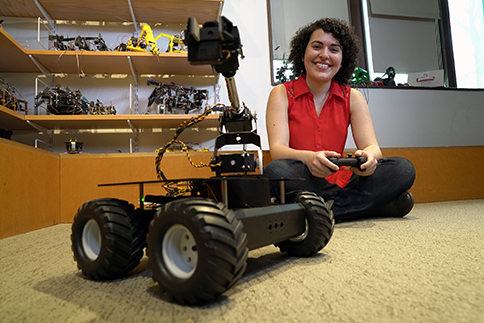ROBOTS
Robots have the potential not to replace humans, but go where humans can't go, says CS major Julia Proft '16.

“My robot has an arm and can grab things,” Proft, a computer science major, says.
“The name was inspired by the Steve Miller song Abracadabra. You know, ‘Abra-abra-cadabra, I want to reach out and grab ya,’” she sings. “It was a spur-of-the-moment thing. I think the name is cute.”
This fall, Proft will be starting a Ph.D. program in computer science at Cornell, but at the moment she’s working with robots, more specifically, the utility of tethers, because she wants to use these machines to help first responders stay safe.
“There’s potential for robots, not to replace humans, but to go where humans can’t go and to collaborate with humans,” Proft says.
“Say you have a collapsed building or a nuclear disaster, you can’t send people in because it’s either impossible to get them in or because it’s a risk to their life. But you can send in robots.”
Proft explains that first responders also can’t send in autonomous robots to disaster areas because smoke or, let’s say, a radiation leak, wreaks havoc on the machine’s sensors. Therefore, a tether is necessary. However, tethers can limit a robot’s maneuverability (a tether twists or knots), so she prototyped Abracadabra to detach and reattach to its tether. While these types of robots already exist, the goal of Proft’s research is to discover ways to increase the utility of tethers.
“First responders have been looking for a robot that can detach itself from its power or communications cable, or even just a belay cable … because if a cable snaps in a disaster area, most of the time you can’t just go in and retrieve the machine.
“And you’ve just lost a $25,000 robot.
“You need a robot that can detach itself, roam around and do whatever it needs to do, and then reattach and get removed from the area.”
Proft’s robot research is part of her honors thesis. She has been working under the supervision of Gary Parker, chair of the computer science department, who stands in an 8-by-8-foot enclosure, squared off by one-foot-high walls made out of wood.
“It’s our colony space,” Parker says.
Looking to the ceiling, he points out a camera. “We can run experiments in this colony space, such as our predator-prey experiment.”
The gnarly sounding experiment involves two robots: the “prey,” which has sensors all around to enhance peripheral vision, like a fly with numerous eyes; and the “predator,” which was built to concentrate vision up front, like a wolf.
The prey is taught to run from the closest object. The predator is programmed to chase. And the two robots battle.
“The idea is for the students to develop problemsolving skills, methods of learning that can be used in different robots and in different environments,” Parker says. “I try to let students be creative.”
Abracadabra is sturdy and rugged. It would make a terrific predator. The bulkiness of Proft’s robot, though, belies its intricacies. These complexities mean that when the machine misbehaves (malfunctions) it’s difficult to debug and figure out the hitch in its giddy-up.
“The hard thing about robotics is that when debugging there are more variables to check when something goes wrong. When programming software it’s most likely your code and not your computer. With a robot it could be software or hardware—something as simple as forgetting to plug in a wire can prevent the entire robot from working,” she says.
“It can be frustrating when you have to check all these little components just to find that ‘one’ missing thing.” Despite these frustrations, like when she’s trying to program the machine to manipulate the tether, and it just won’t work, Proft is happy with how her robot turned out, the first she’s ever constructed.
“You kind of have that love-hate relationship with your creation, but the first time I flipped on the onswitch and it actually worked, that was amazing.
“To be able to make these creations and have them work and especially ones that can help people, it’s the best feeling in the world.
“It’s what drives those of us in the field of computer science to innovate,” she says.